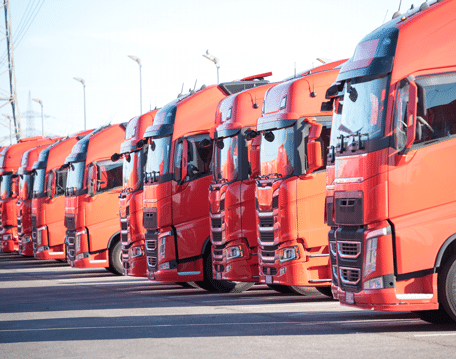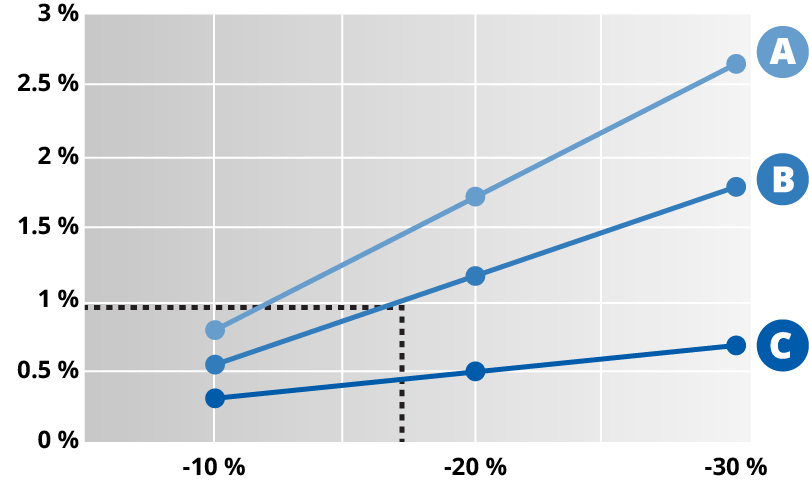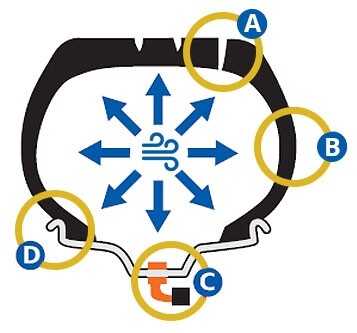
Why is truck tyre pressure essential for your business?
Why is truck tyre pressure essential for your business?
Applying and maintaining the correct inflation truck tyre pressure is key for optimum performance and safety. As we will see, it also avoids problems and allows you to optimise your fuel consumption. Find out what our experts have to say.
SUMMARY:
The tyre is the sole point of contact between the vehicle and the road surface. It is therefore crucial to the safety both of road users and goods transported. For a given load and type of work, in clearly defined conditions, there is only one suitable inflation pressure.
Why is tyre pressure crucial?
The pressure of the air in the tyre is crucial to its correct operation: it is this pressure which both supports and moves loads or people:
-
Safely
-
Durably
-
Economically
-
Comfortably
However, in the surveys conducted by Michelin, tyre pressure emerges as one of the maintenance points which that is often not monitored and maintained as well as it should be. Yet neglecting pressure carries important risks.

Correct truck tyre pressure is essential for your business
The risks of under-inflation and over-inflation
Under-inflation
Under-inflation could result in the tyres running at abnormally high temperatures, leading to thermal degradation of the tyres' components. The degradation is irreversible and can result in a rapid deflation of the tyre.
Also, under-inflated tyres lead to:
-
An increase of rolling resistance and thus vehicle’s fuel consumption
-
A reduction in tyre service life (mileage)
-
An impact on vehicle handling and safety, increasing the risk of aquaplaning
-
A reduction in casing resistance which limits the potential of retreading
Please note that the consequences of running with insufficient truck tyre pressure are not necessarily immediate and may even become apparent after the pressure has been corrected.
Over-inflation
Over-inflation reduces:
- Safety and ride comfort
-
Grip
-
Tyre service life (mileage), particularly on drive axles tyres
Over-inflation can also cause rapid and irregular wear and increased sensitivity to impact (tread damage, casing failure).
The influence of truck tyre pressure on fuel consumption
Tyre pressure has a proven influence on fuel consumption. An unsuitable inflation pressure increases the rolling resistance of tyres and therefore the vehicle's fuel consumption. For example : under-inflation by 1.5 bar (21.7 psi) = 1% excess consumption(1)
This graph shows the relationship between under-inflation and increased fuel consumption for the following vehicles:
A- Tractor + semi-trailer long distance operation
B- Tractor + semi-trailer or rigid truck, short and medium operation
C- Urban bus
% increase in fuel consumption

Graph showing correlation between higher fuel consumption and loss of truck tyre pressure
Under-inflation % relative to the recommended nominal pressure
Why does a tyre lose pressure?
A tyre can lose pressure for various reasons, as shown in the diagram:

four possible reasons for a loss of truck tyre pressure
A- Perforation through the whole structure
B- Natural infiltration through component parts
C- Airtightness of the valve mechanism or airtightness between the valve and rim
D- Airtightness between the rim and the tyre beads
Apart from on-board monitoring systems, a regular, visual pressure check using a pressure gauge is the most common way of detecting problems with air leaks.
How to check truck tyre pressure
Pressure checks should be made on all the tyres on the vehicle, including the spare tyre, using a calibrated pressure gauge. Even if tyres are inflated with nitrogen, the pressure still needs to be checked regularly.
Here are important precautions:
- Check truck tyre pressure when tyres are cold, at ambient temperature. The pressure increases in use: never reduce the pressure of a tyre while it is hot.
- Never re-inflate a tyre which has been running underinflated without a thorough inspection both inside and out.
- If the truck tyre pressure when hot is lower than the suggested pressure, the tyre must be removed and checked, complying with the safety instructions.
- If one tyre appears considerably hotter than the others, it must also be removed and checked complying with the safety instructions.
- Truck tyres on the same axle should have approximately the same pressure.
-
After fitting a tyre, its pressure should be checked 24 hours later.
-
The valve cap is the primary air seal and must always be fitted (NB. The valve core acts as a one way valve to allow the tyre to be inflated; it should not be treated as a seal).
If you have any doubt, discover all our technical guidelines in Michelin databook.
TIP: Download our inflation pressure tables to find out your ideal pressures for trucks and buses:
How do you interpret the different truck tyre pressures?
TYRE PRESSURE | IMPACT | STATUS & ACTION |
Under-inflation of up to -0.5 bar OR Over-inflation of up to +0.5 bar | - Increased safety. - Greater longevity. - Reduced fuel consumption. | ACCEPTABLE PRESSURE: Correct as soon as possible to the suggested level |
Under-inflation between -0.6 and -1 bar | - Reduced longevity. - Increased irregular wear - Increased fuel consumption. | TEMPORARILY ACCEPTABLE PRESSURE: Correct immediately and monitor |
Under-inflation of more than -1 bar | - Rapid deterioration in use with risk of rapid deflation, reduced stability and grip. - Reduction in longevity. Increase in fuel consumption and irregular wear. | UNACCEPTABLE PRESSURE: Demount and inspect the interior for run flat damage. If mounted in dual configuration: demount and inspect adjacent mounted assembly. |
Be aware that:
-
Tyre pressures greater than 10 Bar (145 PSI) are not recommended for normal highway operations.
-
Tyre pressure which are more than 0.6 bar (8 PSI) below the suggested values must be corrected immediately.
Tyres for commercial vehicles should be inflated to a pressure relevant to the load, speed and conditions of use. In all circumstances, the pressures recommended by the manufacturer of the vehicle or tyre must be observed.
TIP:
- Check the tyre pressures regurlarly when the tyres are cold at ambient temperature or after the vehicle has stopped for several hours.
- This information is visible on the tyre, label making it easier to choose wisely.
- NEVER DEFLATE HOT TYRES.
Other articles to find out more:
Need more advice? Discover all MICHELIN truck tyre tips
(1) Internal Michelin source




